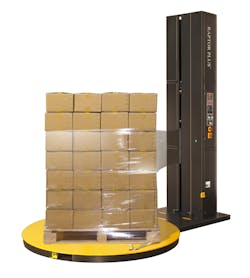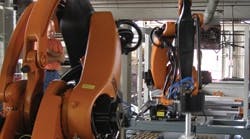Load damage, SKU proliferation, labor scarcity and material waste are all good reasons to reconsider how pallet loads leave your dock. Stretch wrapping is a good place to start. If concerns about justifying the cost of a capital equipment investment have delayed such an analysis, here are considerations to keep in mind when looking at this equipment.
The Right Fit
It’s important to consider what type of stretch wrapper is best suited for your specific application. Think about the size, weight and variability of the loads you will be wrapping. Highly variable loads would benefit from certain types of machinery, such as orbital, horizontal wrappers that unitize the load most securely to the pallet. Stable, light-weight loads of consumer goods would do well with a turntable style wrapper, while unstable or heavy loads would do better with a rotary arm machine. Rotary ring machines can handle heavy and variable loads, such as construction supplies, pet food and beverages while still handling the highest volume lines.
Need for Speed
One should consider the production speeds required. If moving from a hand wrap application to simple automation, a semi-automatic stretch wrapper may be all that is required. Although these machines still require a person to manually attach the film to the load at the beginning of the wrap cycle and cut the film at the end of the cycle, they can achieve rates as high as 35 loads per hour. The labor reduction or improved productivity may justify the relatively low cost of these machines.
If you’ve outgrown your existing stretch wrapper or are adding production, a fully automatic stretch wrapper may meet your needs best. While these machines typically cost more, the savings in labor, improved productivity, and increased versatility may help justify this type of machine. Whether you choose a highly automated ring wrapper that can achieve speeds as high as 150 loads per hour or you prefer the redundancy of two lower volume machines in parallel can depend on available space, labor costs and maintenance expenses.
Living in a Material World
It is important to understand the material savings that can be achieved with a new stretch wrapper. Payback can be quick for equipment that allows you to reduce film usage. These savings are also, typically, the easiest to quantify. For example, film usage can be reduced by almost 30% when purchasing a new machine that would improve the amount of film pre-stretch from 150% to 250%.
Equipment design can also have a major effect on film usage. Almost all automatic turntable and rotary arm machines have a fixed clamp that requires the machine to start and stop at the bottom of the load. A rotary ring type machine has the flexibility to start and stop anywhere on the load. This can result in 25% film savings—often enough to justify a new machine. New machines may also offer opportunities to reduce the number of wraps or move to thinner films. Plus, for companies accounting for sustainability improvements as part of their evaluation, they will likely benefit from the thousands of pounds of film that can be saved.
A Load of Savings
Although film reductions can result in thousands of dollars in savings, it may pale in comparison to the money saved by eliminating load damage and reducing interruptions in production. Study results indicate that annual average unsaleable rates, as a percent of gross sales, are .96 percent for manufacturers, with nearly half of this as a result of damage.[1] Improving load containment could pay back the expense of a new machine—while making the customer much happier.
Likewise, by understanding the cost of production downtime, the justification for a new wrapper may be simple. Production stoppages can cost some companies in excess of $50 per minute. At this rate, eliminating even 20 minutes of downtime a week could quickly pay for a new fully automatic wrapper.
New Technology
Additional labor savings can be achieved by adding an automatic film roll changer or spare carriage that allows for less frequent film changeovers and improves productivity. Performance monitoring systems can provide assurance that the optimal amount of film will be applied to each load. Advances in film tension control can allow for variability throughout the wrap cycle to help reduce load damage and eliminate film breaks. Including an integrated top sheet or automated corner board applicator may eliminate enough labor to help rationalize the cost of a new stretch wrapper.
Case in Point
Hensley Beverage Company had different challenges: Oddly shaped loads and loads encompassing several different products and sizes that would benefit greatly from variable film tension. They found a machine that applies just the right amount of tension at various points on the load, thus reducing product damage and lowering film costs.
Instead of operating with a single tension setting, variable tension control machines allow for increased tension at locations on the load that require extra hold (the base of a sturdy box) and lighter tension where reduced force is beneficial (sharp corners, the top of an open box). Hensley Beverage Company has estimated that this solution has saved it about 1.5 men a day.
Dan Schmidt is business development manager for ITW Muller www.itwmuller.com.
Reverse Logistics





